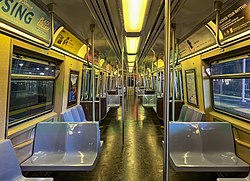| R44 | |
|---|---|
 An R44 train on the Staten Island Railway (SIR) at Oakwood Heights | |
 Interior of a SIR R44 car | |
| In service | 1971–2010 (NYCT cars) 1973–present (SIR cars) |
| Manufacturer | St. Louis Car Company |
| Built at | St. Louis, Missouri, USA |
| Replaced | |
| Constructed | 1971–1973 |
| Entered service |
|
| Refurbished | May 1991 – January 1993, 2007 – 2010 (SIR cars) |
| Scrapped | 2012–2013 (NYCT cars & one damaged SIR car) |
| Number built | 352 |
| Number in service | 57 (SIR cars)[1] |
| Number preserved | 1 |
| Number scrapped | 293 284 (283 NYCT cars and 1 damaged SIR car) 10 in storage (4 NYCT cars and 6 SIR cars)[1] |
| Successor | R160 (NYCT) R211S (SIR) |
| Formation | Single units (SIR), 4 car sets (NYCT) |
| Fleet numbers | 5202–5479 (NYC Subway) 388–435, 436–466 (even) (SIRTOA) (cars originally numbered 100–435, 436–466 (even)) |
| Capacity | A car: 72 (seated) B car: 76 (seated) |
| Operators | New York City Subway (1971–2010) Staten Island Railway (1973–present) |
| Depots | Clifton Yard[2][3] |
| Service(s) assigned | |
| Specifications | |
| Car body construction | Stainless steel with carbon steel chassis and underbody, with fiberglass end bonnets |
| Car length | 74 ft 8.5 in (22.77 m) (over anticlimbers) |
| Width | 10 ft (3,048 mm) (over threshold) |
| Height | 12.08 ft (3,682 mm) |
| Platform height | 3.76 ft (1.15 m) |
| Doors | 8 50-inch-wide side doors per car (4 per side) |
| Maximum speed | Test: 87.75 mph (141.22 km/h) Service: 55 mph (89 km/h)–60 mph (97 km/h) |
| Weight | A train car: 88,950 lb (40,347 kg) B train car: 84,530 lb (38,342 kg) |
| Traction system | NYC Subway: Westinghouse E-CAM XCA448F propulsion with Westinghouse 1447F motors 115 hp (85.8 kW) on all axles Staten Island Railway: General Electric SCM-CAM 17KG192A1 propulsion with GE 1257E1 motors 115 hp (85.8 kW) on all axles |
| Prime mover(s) | electric motor |
| Acceleration | 2.5 mph/s (4.0 km/(h⋅s)) |
| Deceleration | 3.0 mph/s (4.8 km/(h⋅s)) (Full Service) 3.2 mph/s (5.1 km/(h⋅s)) (Emergency) |
| Electric system(s) | Third rail, 600 V DC |
| Current collector(s) | Contact shoe |
| Braking system(s) | NYC Subway: Westcode (dynamic and friction), WABCO tread brake unit Staten Island Railway: WABCO RT5C (dynamic and friction), WABCO tread brake unit |
| Safety system(s) | ATO, dead man's switch, pulse code cab signaling, tripcock |
| Headlight type | halogen light bulbs |
| Track gauge | 4 ft 8+1⁄2 in (1,435 mm) standard gauge |
The R44 is a New York City Subway car model built by the St. Louis Car Company from 1971 to 1973 for the B Division and the Staten Island Railway (SIR). The cars replaced many R1-R9 series cars, and all remaining 1925 Standard Steel built SIRTOA ME-1 trains, providing Staten Island with a new fleet of railcars. The R44 fleet originally consisted of 352 cars, of which 57 remain in service, all on the Staten Island Railway.
The first R44 cars entered service on the subway on April 19, 1972, and on the Staten Island Railway on February 28, 1973. Various modifications were made over the years to the R44 fleet. The R44s set the world speed record for a subway car in 1972, reaching a top speed of 87.75 mph (141.22 km/h). In the early 1990s, the R44 cars were rebuilt by Morrison–Knudsen for the New York City Transit Authority. Though the R160 order replaced all New York City Subway-operated R44s from December 18, 2009[4] to September 16, 2010 because of structural integrity issues found on them, the Staten Island Railway fleet remains in operation and is to be replaced by the R211 order by 2024–2025. As of 2024, the R44s are the oldest active rolling stock within the NYCT system, following the retirement of the R32s.
- ^ a b "Instagram".
- ^ "Car/Yard Assignments" (PDF). Archived from the original (PDF) on December 5, 2019.
- ^
- 'Subdivision 'A' Car Assignment Effective December 19, 2021'. New York City Transit, Operations Planning. December 17, 2021.
- 'Subdivision 'B' Car Assignment Effective December 19, 2021'. New York City Transit, Operations Planning. December 17, 2021.
- ^ Chiasson, George (March 2010). "New York City Subway Car Update" (PDF). The Bulletin. 53 (3). Electric Railroaders' Association: 7. Retrieved March 1, 2022.
